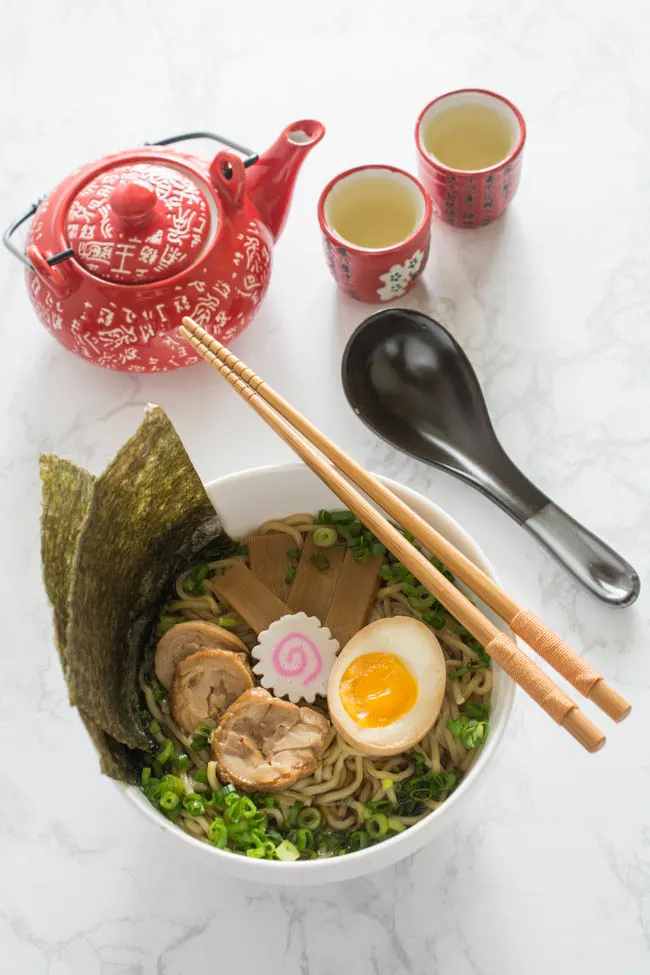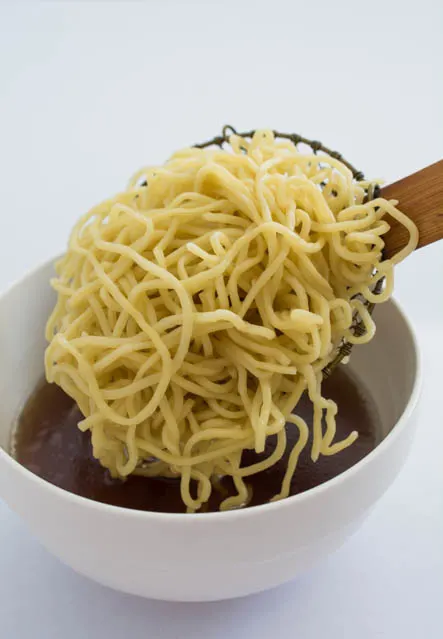Traditional Shoyu Ramen features a savory soy-sauce based clear broth and ramen noodles with classic toppings such as chashu, seasoned bamboo shoots, and a half-boiled seasoned egg.This is the sixth and final part of the Ramen At Home series for Traditional Shoyu Ramen.

Shoyu Ramen is one of the most popular Japanese ramen flavors next to shio (salt) ramen and miso ramen. Shoyu Ramen features a light and savory soy-sauce based broth, and classic Japanese ramen toppings such as chashu, menma (seasoned bamboo shoots) and half-boiled ajitama (seasoned egg).
The naruto (Japanese fish cake with a pink whirlpool pattern) in the middle adds a signature look to the bowl.
Making traditional ramen from scratch can be quite time-consuming, but the results are well worth the wait and the effort. It can take 2 – 3 days to prepare all of the different ingredients – that may seem overwhelming but with a little planning, you’ll be able to breeze through each step (I’ve outlined a suggested timeline below to help you plan these steps).
I had been wanting to try making my own ramen for a while now but honestly, I was a bit intimidated.
When I was introduced to Brian’s cookbook, I knew that this would be a great opportunity to take the plunge and give it a try!
Brian is the author of the ramenadventures.com blog and host of the Ramen Adventures YouTube Channel. He currently lives in Japan, where he chronicles his experience eating and making ramen.
His new cookbook, Ramen at Home, is a fantastic resource for the beginner with plenty of guidance and step-by-step instructions, and also new recipes for ramen lovers to try (I’ve got my eye on the Smoked Salmon Miso Ramen!)
This Traditional Shoyu Ramen recipe is from Brian’s cookbook. There are several components to this dish so instead of creating one super-long post with 6 separate recipes, I have broken this down into a 6 part series.
Here are the links to the key ingredients in this series, along with the estimated preparation time:
- Shoyu Tare (35 minutes)
- Chicken Chashu (55 minutes)
- Menma (Seasoned Bamboo Shoots) (40 minutes + overnight)
- Half-Boiled Ajitama (Seasoned Eggs) (15 minutes + overnight)
- Basic Clear Chicken Soup (4 1/2 hours + overnight)
Once you have prepared these ingredients, you can keep most of them in the refrigerator for a few days, which means that you can make them ahead of time during the weekend, then prepare the ramen for dinner even on a busy weeknight! After you have all the ingredients ready, it takes just minutes to put together.
Here is the preparation sequence I recommend, along with some options with regards to the timeline.
If this is your first time making your own ramen, I would recommend Timeline 1 where you spread out the preparation over 3 days to avoid feeling overwhelmed.
Recommended Sequence and Timelines
Timeline 1:
3 days. Spreading out the prep time a little to avoid feeling overwhelmed; helpful if this is your first attempt at ramen.
Day 1 (90 mins)
- Shoyu Tare
- Chicken Chashu
- Prepare the Negi (scallions)
- Note: Don’t forget to save the seasoning liquid from the Chicken Chashu!
Day 2 (55 mins to prepare, season overnight)
- Menma (Seasoned Bamboo Shoots)
- Half-Boiled Ajitama (Seasoned Eggs)
- (Soak the konbu and shiitake mushroom overnight for the Chicken Soup)
Day 3 (4 hours, 20 minutes)
- Basic Clear Chicken Soup
- Cook the ramen noodles
- Put it all together. It’s ramen time!!
Timeline 2:
2 days. Great weekend project!
Day 1 (3 hours + season overnight)
- Shoyu Tare
- Chicken Chashu
- Menma (Seasoned Bamboo Shoots)
- Half-Boiled Ajitama (Seasoned Eggs)
- Prepare the Negi (scallions)
- (Soak the konbu and shiitake mushroom overnight for the Chicken Soup)
Day 2 (4 hours, 20 minutes)
- Basic Clear Chicken Soup
- Cook the ramen noodles
- Put it all together. It’s ramen time!!
How to Make Traditional Shoyu Ramen
Put 1/2 a cup of the Shoyu Tare and 5 cups of the Basic Clear Chicken Soup in a medium saucepan. Mix and bring to a simmer over low heat.

Cook the ramen noodles in a large pot of boiling water. Fresh ramen that has been cut to a standard thickness (about 1 mm) will cook in about 1 – 2 minutes.
The cookbook does include a recipe for fresh ramen noodles (Chukasuimen), but I used fresh ramen noodles that I purchased from a local Japanese supermarket. If you have trouble finding fresh ramen noodles and don’t want to make your own, you can purchase dried ramen noodles at your local Asian supermarket or online.
Simply follow the cooking instructions on the packet to cook the noodles.
About 30 seconds before the noodles are finished cooking, ladle the soup into 4 ramen bowls.

Drain the noodles using a spider skimmer, taking care to shake off as much excess water as you can.
Carefully place some noodles in each bowl of soup, keeping them tidy.

Place 1 – 2 slices of Chicken Chashu, 1 slice of naruto (Japanese fish cake with pink whirlpool design), 1 half-boiled ajitama, 3 – 4 pieces of Menma, and a sprinkle of *Negi neatly on the ramen. Perch 1 sheet of nori seaweed on the inside of the bowl.
*Negi is essentially finely chopped scallions.
To prepare, soak the scallions in a bowl of water for 10 – 15 minutes. Drain the water, then store in an air-tight container for up to 3 days. This process will lessen the harsh onion flavor that takes away from the rest of the bowl.

Serve and slurp!

Traditional Shoyu Ramen
Ingredients
- 1/2 cup Shoyu Tare
- 5 cups Basic Clear Chicken Soup
- 1 1/3 lbs fresh ramen noodles
- 4 - 8 slices Chicken Chashu
- 4 sheets nori seaweed
- 4 slices naruto (Japanese fish cake)
- 4 Half-Boiled Ajitama
- 12 - 16 pieces Menma
- Negi scallions
Instructions
- With all your ingredients ready to go, bring a large pot of water to boil over medium-high heat.
- Heat your ramen bowls by filling them halfway with hot water. The bowls don't need to be scalding, but they should be hot to the touch. Dump out the hot water and dry the bowls with some paper towels or a clean towel.
- Put the tare and soup in a medium saucepan. Mix and bring to a simmer over low heat.
- Cook the noodles in the large pot of boiling water. Ramen that has been cut to a standard thickness (about 1 mm) will cook in 1 to 2 minutes.
- About 30 seconds before the noodles are finished cooking, ladle the soup into the ramen bowls.
- Drain the noodles, taking care to shake off as much excess water as you can. Carefully place some noodles in each bowl of soup, keeping them tidy.
- Place 1 - 2 slices of chashu, 1 piece of nori, 1 slice of naruto, 1 egg, 3 or 4 pieces of menma, and a sprinkle of negi neatly on the ramen. (The sheet of nori should be placed so just the tip is in the soup, with the rest perching on the side of the bowl. The naruto fish cake should go right in the middle).
- Serve immediately.



julian
Monday 19th of October 2020
I hope one day i get to try the naruto ramen\ ichiraku shoyu ramen
Menma (Seasoned Bamboo Shoots) for Ramen - Wok & Skillet
Friday 26th of June 2020
[…] Menma (Seasoned Bamboo Shoots) is a classic Japanese ramen topping but can also be enjoyed as a snack. Slightly crunchy and extremely flavorful. This is Part 3 of the Ramen At Home series for Traditional Shoyu Ramen. […]
Half-Boiled Ajitama (Seasoned Eggs for Ramen) - Wok & Skillet
Friday 26th of June 2020
[…] Half-Boiled Ajitama (Seasoned Ramen Eggs) have slightly firm egg whites and luscious custard-like yolks. The sweet soy seasoning give the eggs unbelievable flavor. Famously used as a topping for ramen but can be enjoyed as a snack anytime. This is Part 4 of the Ramen At Home series for Traditional Shoyu Ramen. […]
Chicken Chashu for Ramen - Wok & Skillet
Friday 26th of June 2020
[…] Chicken Chashu is a spin on the popular Pork Belly Chashu ramen topping. Rolled chicken thighs are pan-fried, braised in a sweet soy sauce, then left to marinade to soak in the delicious seasoning. This is Part 2 of the Ramen at Home series for Traditional Shoyu Ramen. […]
Shoyu Tare (Soy Sauce Seasoning for Ramen) - Wok & Skillet
Tuesday 23rd of June 2020
[…] Shoyu Tare is the soy sauce seasoning and concentrated flavor base used in Japanese Shoyu Ramen. Tare is one of the most important elements in a good bowl of ramen. This is Part 1 of the Ramen At Home series for Traditional Shoyu Ramen. […]